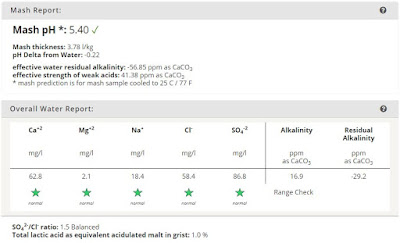Brewing - Golden Mild Ale
Yeast prep - March 21, 2020
Prepared a 2L starter with yeast saved from 2nd overbuilt starter (Ordinary Bitter, March 2nd). Reserved 500ml for future starter, gave 400ml to a friend and pitched remaining 1L to Mild Ale.
Golden Mild Ale Brewday - March 22, 2020
44L (Primary) | 1.039 OG | 16 IBU | 5 SRM
Part 1 - Setup
- Grist -
81.1% | 6kg Canada Malting Superior Pale Ale Malt (3.1L)
13.5% | 1kg Weyermann Munich Type II (8L)
05.4% | 400g Simpsons Crystal Light (34L)
- Hops -
|| Kettle ||
|| Kettle ||
30g East Kent Golding (4.5% AA) @ 60 minutes
30g East Kent Golding (4.5% AA) @ 20 minutes
30g East Kent Golding (4.5% AA) @ 5 minutes
30g East Kent Golding (4.5% AA) @ 20 minutes
30g East Kent Golding (4.5% AA) @ 5 minutes
- Water -
56L treated with 1 campden tab to remove chloramine
56L treated with 1 campden tab to remove chloramine
Source Profile (mg/l):
Ca+2 = 8.7
Mg+2 = 2.1
Na+ = 18.4
Cl- = 6.7
SO4-2 = 27
Alkalinity (ppm as CaC03) = 32.5
pH = 9.4
Mg+2 = 2.1
Na+ = 18.4
Cl- = 6.7
SO4-2 = 27
Alkalinity (ppm as CaC03) = 32.5
pH = 9.4
|| Salts & Acid ||
Mash - 2ml (88%) Lactic Acid, 6g Calcium Chloride, 6g Calcium Sulfate
Mash - 2ml (88%) Lactic Acid, 6g Calcium Chloride, 6g Calcium Sulfate
Resulting Profile (mg/l) :
Ca+2 = 62.8
Mg+2 = 2.1
Na+ = 18.4
Cl- = 58.4
SO4-2 = 86.8
Alkalinity (ppm as CaC03) = 16.9
Residual Alkalinity (ppm as CaC03) = -29.2
Brewer's Friend Mash Report
Ca+2 = 62.8
Mg+2 = 2.1
Na+ = 18.4
Cl- = 58.4
SO4-2 = 86.8
Alkalinity (ppm as CaC03) = 16.9
Residual Alkalinity (ppm as CaC03) = -29.2
Brewer's Friend Mash Report
Part 2 - Mash
Mash salts added directly to the milled to grist
Lactic acid added to half the brewing liquor (28L)
Mashed in @ 73C/162F
Target mash pH 5.40 (calculated @ 25C)
Mashed @ 65.5C/152F
Mashed in @ 73C/162F
Target mash pH 5.40 (calculated @ 25C)
Mashed @ 65.5C/152F
After 60 minutes, vorlauf and collected 1st runnings
At the start of the boil added 1st hop addition (60 minutes)
With 20 minutes remaining, added 2nd hop addition
With 5 minutes remaining, added 3rd hop addition, whirlfloc
At flame-out, added hop filter and immersion chiller
With 5 minutes remaining, added 3rd hop addition, whirlfloc
At flame-out, added hop filter and immersion chiller
Chilled wort and transferred to fermenter
 |
| 43.5L Transferred to Primary |
Day 0 - 16:00 - Pitched 1L (500ml/carboy) @ 14C, carboys placed inside the fermentation freezer with heat lamp and warmed to 20C
Day 1 - 16:00 - Temperature steady at 20C, active fermentation
Day 3 - 10:00 - Increased temperature to 21C
Day 6 - 21:00 - Removed heat controller. Lid left shut to try and retain heat
Day 12 - 11:00 - Moved carboys from fermentation chamber to a colder spot to further condition
Day 18 - 15:00 - Racked both carboys to keg. FG measures 1.015, 62% Atten for an ABV of 3.1%
Day 20 - 15:00 - There is something very wrong with this beer. Having split off my starter 3-ways, I believe I may have inadvertently and significantly under-pitched. Combine this with the fact that I did not aerate the beer, the resulting conditions were likely too stressful for the yeast. Additionally, since I brewed both APA and IPA very closely to the Mild, my standard heating solution was not available. For the Mild, I improvised and used a incandescent lamp (as the heat source) in conjunction with a temperature controller. Perhaps the heat cycles were too strong? Maybe my temperature controller probe was not well placed and therefore provided incorrect temperature read-outs? What every the case, I believe the specific flaw is excessive ester formation, specifically Isoamyl Acetate which can be directly attributed to poor temperature control (too hot) and poor yeast conditions (under-pitch). In short, it smells and tastes like pears (but not in a good way). Some online brewing literature suggests the effect may decrease with aging. I plan to give the beer a couple more weeks in the kegs (at ambient) to see if it's heading the right direction otherwise I'll be dumping it down the drain.
Day 1 - 16:00 - Temperature steady at 20C, active fermentation
 |
| +24hrs @ 20C |
Day 3 - 10:00 - Increased temperature to 21C
Day 6 - 21:00 - Removed heat controller. Lid left shut to try and retain heat
Day 12 - 11:00 - Moved carboys from fermentation chamber to a colder spot to further condition
Day 18 - 15:00 - Racked both carboys to keg. FG measures 1.015, 62% Atten for an ABV of 3.1%
 |
| 1.015 (Temperature Corrected) |






Comments
Post a Comment